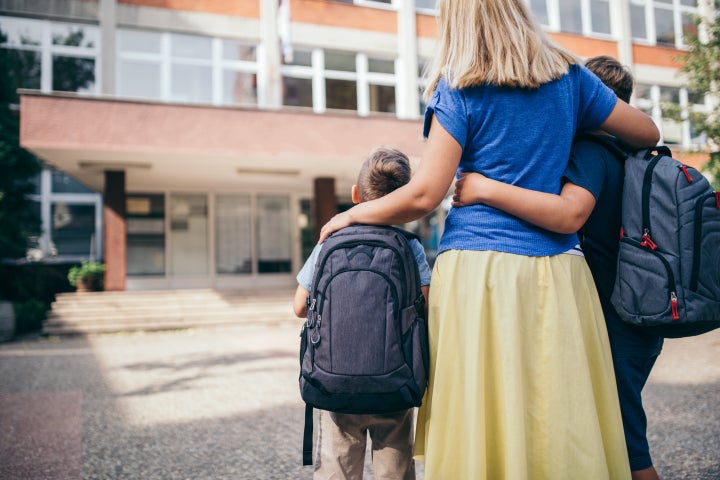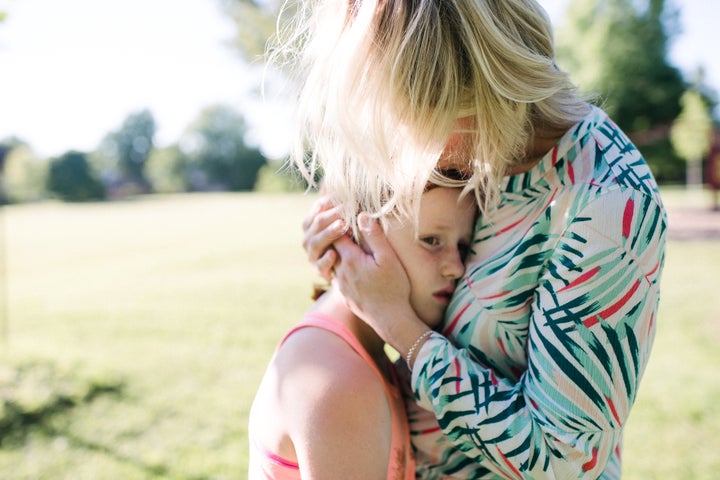The topic of school safety resurfaces every time there is a school shooting — which, in the United States, is increasingly frequent: According to the Washington Post, there have been 386 school shootings since Columbine.
In these horrifying moments, parents must face questions from their children, as well as their own concerns about safety.
Although it’s important to respond to kids’ queries and have conversations around school safety, broaching this topic without causing unnecessary fear or anxiety can pose a challenge.
To offer guidance, HuffPost spoke to a couple of school safety experts about the best ways to tackle these issues with kids. Here are eight things to keep in mind when discussing school safety with children. Much of the advice can apply to parents and educators alike.
Take A Glass-Half-Full Approach
“We advocate for a glass-half-full approach with kids ― focusing on the positive,” said Michele Gay, who co-founded the nonprofit Safe and Sound Schools after losing her daughter Josephine in the Sandy Hook Elementary School shooting. Instead of emphasizing potential dangers, she recommends drawing attention to places where students can find examples of safety and various things that support safety in school.
“It’s all about orienting students to their space and using kid-friendly language,” she said. “Always make sure that you’re not using scary imagery or ‘bad guys’ or anything like that. Just talk about safe and unsafe. ’If you feel unsafe, how can you get to safety and where might you find safety? Who might help you find safety?”
Don’t Try To Scare Kids
Amanda Klinger, the director of operations for the Educator’s School Safety Network, echoed Gay’s sentiment of positivity. Over the years, news reports have shown schools conducting hyperrealistic active-shooter drills in which police fire blanks or shout and pound on doors ― events that have been shown to traumatize students.
“That’s not increasing the skills of the people in that school building,” Klinger said. “When we have actual events, and we have to respond, yes, that’s going to be scary for kids. But when I do a drill with kindergarteners, it shouldn’t be, ‘Boys and girls, when the homicidal maniac with the AK-47 comes to kill us, what would we do?’ There’s no reason we should do that.”
“It shouldn’t be, ‘Boys and girls, when the homicidal maniac with the AK-47 comes to kill us, what would we do?’”
- Amanda Klinger, Educator’s School Safety Network
Like Gay, Klinger noted that it’s important to focus on finding safety. Teaching young kids how to quickly evacuate, whether it’s because of a gunman or a collapsed roof, doesn’t have to be frightening.
“Ask kindergarteners what we’d need to do if we needed to get out of the classroom in a hurry so that no one gets trampled or left behind,” she explained. “We’d be careful with our bodies when we leave, we’d follow the teacher, we’d pay attention and we’d use our listening ears and our looking eyes. That’s not scary.”
Use Age-Appropriate Activities
One activity that Safe and Sound Schools promotes in classrooms is a game called Safety Tag. “It works great with little ones, and all you need is a pack of Post-Its,” said Gay.
Educators gather their students in their classroom, cafeteria, gym or hallway and give each child a handful of Post-it Notes. Then they can ask the students to walk around the room and use a Post-it to tag anything they see that represents safety, makes them feel safe or could support their safety in various circumstances.
“Within a matter of 60 seconds, the room is usually littered with Post-its,” Gay explained, adding that kids often tag things like the fire extinguisher, the first-aid kit and even the teacher. “That kind of approach gets them to stop and see that, in this uncertain world where we unfortunately hear about tragedy after tragedy, we are doing an awful lot and have many resources to support safety and keep everyone safe in schools.”
Parents can do this sort of exercise with their kids as well, by asking them to find five things that keep them safe at school and report back when they return home that day.

“That’s a great conversation starter for parents who want to make sure their children are aware of those things and know how to utilize them if they should need them ― without coming at it from that really negative, worst-case scenario angle,” Gay said.
There are also many age-appropriate books that teach kids about safety. Gay recommends The Lockdown Drill by Deputy Becky Coyle. “The book introduces in a gentle, kid-friendly way what this safety procedure is and why we do it in schools. It’s good to sit down in a comfortable, cozy environment with kids to curl up with a helpful book. It’s a no-stress way to open the door to these conversations.”
Recognize Safety Comes In Many Forms
Gay and Klinger both emphasized that school safety encompasses so much more than active-shooter drills and security checks. Other major safety issues include earthquakes, tornadoes, fires, floods, blizzards, bullying, sexual violence and playground injuries.
Rather than harping on school safety events that make national news, it’s more important to focus on the specific risks that students are more likely to face at their particular school.
“If my school is a mile downwind from a chemical plant, that’s a more likely hazard than other things,” Klinger said. “That doesn’t mean we need to be paralyzed by fear, but it means we need to see if we’ve addressed that risk.”
“Having an additional lock or buzzer does nothing if the biggest risk we face at school is that we don’t have adequate supervision at dismissal and a kid is going to be hit by a bus ... or the LGBT kid that’s getting bullied.”
- Amanda Klinger
Klinger said she gets concerned when she sees so much expenditure on strengthening the security of buildings. “Having an additional lock or buzzer does nothing if the biggest risk we face at school is that we don’t have adequate supervision at dismissal and a kid is going to be hit by a bus ... or the LGBT kid that’s getting bullied. We need to make sure what we’re doing is part of a comprehensive all-hazards approach.”
Focus On Building Life Skills
“When we’re talking about safety, we’re talking about life skills,” Gay explained. “Those things that we teach regarding safety in school can apply out in the world, at home, in the grocery store, at the movies, at the mall. Wherever you are, wherever you go, you want to take a little time to orient yourself. The information and behaviors kids learn can serve them for the rest of their lives.”
Both Gay and Klinger noted that “stop, drop and roll” is a classic life skill students learn as part of safety lessons in school. “If you think about it, the thought of burning to death sounds really terrifying,” Klinger said. “But we’re able to talk to kids about ‘stop, drop and roll,’ and it doesn’t cause the chaos, fear and anxiety that we see around other conversations about school safety.”
To that end, it’s crucial that educators frame these discussions in a way that helps students and parents understand they’re doing different safety drills not because schools are fundamentally terrible, dangerous places, but because these are life skills.

“It’s about knowing how to respond appropriately, how to follow directions, how to be aware of your surroundings,” Klinger said. “Asking yourself, how would I evacuate this building if the roof collapsed?”
Know What Their Schools Are Teaching
Many parents, especially around the start of the school year, have questions about what’s going on with safety in their child’s school.
“Historically, this is not a conversation we invited parents to be a part of. When you start the school year as a parent, you receive a lot of paperwork ― including forms for parents to sign up for committees, projects or other types of volunteering ― but there’s hardly ever anything related to safety that involves parents,” Gay said.
As parents come forward and ask questions, however, this has shifted a bit, as schools are sharing more information.
“Of course, schools aren’t going to give parents the alarm codes or pass out the blueprints, and things like that. But certainly, they can and should be telling them about protocols that are in place,” she added.
Gay offered a number of questions parents should consider asking teachers: Which drills do you practice? How many times a year do you practice them? What kind of teaching goes on beforehand? How many ways are you able to quickly secure the classroom if you need to? How many ways are you able to get out of this classroom if you need to? In what ways are you able to communicate? Do you feel there’s more you need that parents can provide? How can I help?
Perhaps the biggest question, however, is: What kind of language do you use with my child to talk about these issues and prepare them for safety in a variety of circumstances? This question is significant because parents already have the basic math and reading education to support those curriculums at home, but they likely don’t know what their kids are learning about safety.
“Are they saying, ‘Run, hide, fight’ or ‘Get out, keep out and hide out'?”
- Michele Gay, Safe and Sound Schools
“The safety curriculum needs to be supported by parents at home, too, just like science or reading,” Gay said. “So what words are they using in school? Are they saying, ‘Run, hide, fight’ or ‘Get out, keep out and hide out’? Are they using the word ‘violence’ or different vocabulary? That way, parents can weave that language into everyday conversation and help them learn about safety.”
Beyond questions about language and protocols, parents should also ask what their roles are in the case of a crisis.
“Are you expecting me to stay at home, stay informed and wait to get the word about what I’m supposed to do next?” Gay said. “If so, what’s the most reliable way to get that information? Is it our local news station? The school website? Twitter? What tools do I have for getting information, and which ones do you want me using?”
Be Realistic And Reassuring
“I think that when parents talk to their students, there needs to be a real discussion of how statistically unlikely these events are,” Klinger said. Although ESSN’s research has shown a recent uptick in school-based violence and threats, she still emphasized that it remains statistically unlikely a given child’s school will have an active-shooter event.
It’s important to ask kids to share their concerns, hear them out and respond in a realistic, reassuring way. Parents can note these threats are real, but many of them are not likely ― and even though that may be the case, there are still many ways to prepare for them in case they do come to pass. Getting kids involved in the preparation process can also be encouraging.

Use Resources
There are resources for parents that can help inform discussions about school safety with kids. The Safe and Sound Schools website offers safety toolkits that include a questionnaire for parents, as well as a specific “Parents for Safe Schools” guidelines.
The ESSN website also offers free resources about moving beyond strictly security or active-shooter-focused approaches. Klinger and her mother, ESSN co-founder Amy Klinger, published a book called Keeping Students Safe Every Day: How to Prepare for and Respond to School Violence, Natural Disasters, and Other Hazards, which is geared toward educators and administrators but has gotten positive feedback from parents as well. For parents looking to learn more about these issues, Amanda Klinger suggested the University of Virginia’s Model for Student Threat Assessment and the U.S. Secret Service’s Operational Guide for Preventing Targeted School Violence.
Klinger also recommended parents look to school boards for guidance about what makes sense and what the best practices are. “Parents can advocate for change. It’s important to figure out what’s best for students, not what’s convenient for adults.”